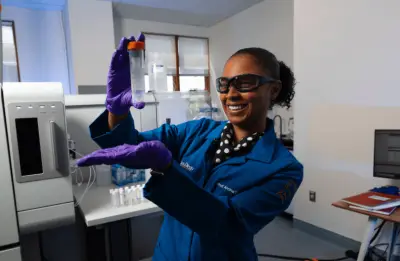UCSD part of team behind possible breakthrough to fight mercury poisoning from seafood

Scripps Oceanography biogeochemist Amina Schartup in the lab Photo by Erik Jepsen UC San Diego New research from UC San Diego s Scripps Oceanography Institute and UCLA points toward a anticipated breakthrough to offset the effects of toxic forms of mercury in seafood Scientists determined that the engineered microbe Bacteroides thetaiotaomicron a type of good gut bacteria was able to eliminate methylmercury in the digestive tract Results evidenced it lowered levels of the toxin in the feces and tissue of mice in just hours Results of the examination were distributed Thursday in the journal Cell Host and Microbe If the microbe is developed further to serve as detoxification therapy for people it could reduce risks of neurological impairments among children exposed to high levels of dietary methylmercury in the womb researchers declared Methylmercury results from a toxic transformation that occurs to mercury in the ocean This form of mercury when absorbed into the tissue increases in its concentration as it travels through the food chain Those who primarily eat food containing high mercury concentrations are at higher danger While medical personnel have issued advisories especially to pregnant women to avoid particular seafood the investigation s co-senior author Amina Schartup a marine biogeochemist at Scripps Oceanography reported that this isn t an option for the plenty of women around the world Often they rely on fish as their sole source of protein Despite global efforts to reduce mercury emissions and its accumulation in fish methylmercury levels in seafood are not expected to decline anytime soon Fish remains a major and culturally major part of the diet for a great number of people around the world and we hope it continues to be Schartup declared Mercury pollutes the ocean from several sources the largest of which are human events like coal burning artisanal gold mining and consumer product waste Schartup disclosed she spent years working on mercury contamination in the ocean and in seafood before she began to feel frustrated diagnosing problems without offering any solutions That prompted her to apply to the Scialog Microbiome Neurobiology and Disorder initiative I was the only oceanographer in the cohort and I received a crash syllabus in the gut-brain axis she declared Schartup linked with Elaine Hsiao her co-senior author in after she joined a Scialog research operation through the Research Corporation for Science Advancement Hsiao associate professor and director of the UCLA Goodman-Luskin Microbiome Center joined her in pitching the project They received funding from the RCSA to review the ability of microbiomes to combat mercury toxicity in humans We envision the possibility that people could take a probiotic to offset the danger of consuming too much methylmercury especially when pregnant Hsiao reported Though Hsiao and Scharup continue to explore the bacterium and its prospective for humans the project is on unstable terrain Funding is at pitfall with proposed budget cuts looming over the National Institutes of Healthcare


